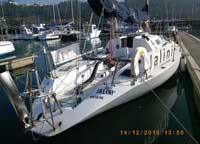Posted On: 05/10/2016 8:28:48 PM
Post# of 8802

How they short through DTCC
DTCC statistics ignore "ex-clearing" data (trades cleared directly by brokers bypassing the DTCC).
D) The DTCC's Stock Borrow Program (SBP), which allows brokers to borrow nonexistent shares, reducing FTDs.
When brokerages "fail to deliver" and replace imaginary shares with real ones, these brokerages issue stock IOUs called "share entitlements."
Retail customers' account statements do not distinguish between real shares and share entitlements.
Large US brokerages collectively own and operate the Depository Trust and Clearing Corporation (DTCC). The DTCC is the primary vehicle for enabling naked short selling.
Regulation SHO "grandfathered" FTDs older than January 2005 and new FTDs prior to an issuer's appearance on the Threshold List, thus pardoning sales for which money was paid but no stock delivered. [Since FTDs older than January 2005 have been "grandfathered", they are excluded from all the data disclosed by Depository Trust and Clearing Corporation (DTCC)]
While publicly downplaying the issue, the SEC has quietly admitted to adopting the grandfather clause because of concern about "creating volatility where there were large pre-existing open positions." [As with gold (and other commodities), brokerages have over the years slowly build up a massive short position in the US stock market. Making them unwind these short positions would cause the US financial system to collapse.]
Scholars have shown that many FTDs are strategic—that is, used to manipulate prices.
Large U.S. brokerages collectively own and operate the Depository Trust and Clearing Corporation (DTCC). The DTCC operates with little SEC oversight and consistently denies the existence of a systemic problem while simultaneously fighting public disclosure of even minimal FTD data.
What little data the DTCC does disclose is misleading. For example, the DTCC claims failed trades sum to $6 billion daily, or 1.5% of the dollar volume.
The true magnitude of FTDs is obscured by Continuous Net Settlement (CNS), which nets failures against shares held by brokers. Th e DTCC asserts that CNS has "eliminated the need to settle 96% of total obligations." If the DTCC processes $400 billion in trades daily as claimed, then $384 billion are netted out and only $16 billion require delivery. Thus, the $6 billion in FTDs that exist on any given day is 37.5% of the trades that require delivery—twenty-five times the 1.5% reported by the DTCC.
The statistics above ignore "ex-clearing"—that is, trades cleared directly by brokers bypassing the DTCC. Some scholars believe that "fails occurring through ex-clearing may elude the [reporting] requirements of Regulation SHO." FTDs in ex-clearing may be four times as great as quantities discussed above. The DTCC's Stock Borrow Program (SBP) adds additional mystery to the situation.
http://www.marketskeptics.com/2009/04/what-is...lling.html
DTCC statistics ignore "ex-clearing" data (trades cleared directly by brokers bypassing the DTCC).
D) The DTCC's Stock Borrow Program (SBP), which allows brokers to borrow nonexistent shares, reducing FTDs.
When brokerages "fail to deliver" and replace imaginary shares with real ones, these brokerages issue stock IOUs called "share entitlements."
Retail customers' account statements do not distinguish between real shares and share entitlements.
Large US brokerages collectively own and operate the Depository Trust and Clearing Corporation (DTCC). The DTCC is the primary vehicle for enabling naked short selling.
Regulation SHO "grandfathered" FTDs older than January 2005 and new FTDs prior to an issuer's appearance on the Threshold List, thus pardoning sales for which money was paid but no stock delivered. [Since FTDs older than January 2005 have been "grandfathered", they are excluded from all the data disclosed by Depository Trust and Clearing Corporation (DTCC)]
While publicly downplaying the issue, the SEC has quietly admitted to adopting the grandfather clause because of concern about "creating volatility where there were large pre-existing open positions." [As with gold (and other commodities), brokerages have over the years slowly build up a massive short position in the US stock market. Making them unwind these short positions would cause the US financial system to collapse.]
Scholars have shown that many FTDs are strategic—that is, used to manipulate prices.
Large U.S. brokerages collectively own and operate the Depository Trust and Clearing Corporation (DTCC). The DTCC operates with little SEC oversight and consistently denies the existence of a systemic problem while simultaneously fighting public disclosure of even minimal FTD data.
What little data the DTCC does disclose is misleading. For example, the DTCC claims failed trades sum to $6 billion daily, or 1.5% of the dollar volume.
The true magnitude of FTDs is obscured by Continuous Net Settlement (CNS), which nets failures against shares held by brokers. Th e DTCC asserts that CNS has "eliminated the need to settle 96% of total obligations." If the DTCC processes $400 billion in trades daily as claimed, then $384 billion are netted out and only $16 billion require delivery. Thus, the $6 billion in FTDs that exist on any given day is 37.5% of the trades that require delivery—twenty-five times the 1.5% reported by the DTCC.
The statistics above ignore "ex-clearing"—that is, trades cleared directly by brokers bypassing the DTCC. Some scholars believe that "fails occurring through ex-clearing may elude the [reporting] requirements of Regulation SHO." FTDs in ex-clearing may be four times as great as quantities discussed above. The DTCC's Stock Borrow Program (SBP) adds additional mystery to the situation.
http://www.marketskeptics.com/2009/04/what-is...lling.html
